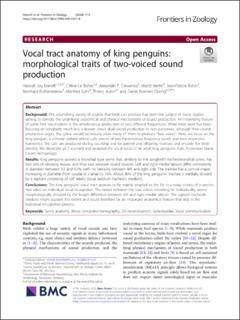| dc.contributor.author | Kriesell, Hannah Joy | |
| dc.contributor.author | Le Bohec, Céline | |
| dc.contributor.author | Cerwenka, Alexander F. | |
| dc.contributor.author | Hertel, Moritz | |
| dc.contributor.author | Robin, Jean Patrice | |
| dc.contributor.author | Ruthensteiner, Bernhard | |
| dc.contributor.author | Gahr, Manfred | |
| dc.contributor.author | Aubin, Thierry | |
| dc.contributor.author | Düring, Daniel Normen | |
| dc.date.accessioned | 2022-08-08T08:24:00Z | |
| dc.date.available | 2022-08-08T08:24:00Z | |
| dc.date.created | 2021-01-11T11:27:46Z | |
| dc.date.issued | 2020 | |
| dc.identifier.citation | Frontiers in Zoology. 2020, 17 . | en_US |
| dc.identifier.issn | 1742-9994 | |
| dc.identifier.uri | https://hdl.handle.net/11250/3010542 | |
| dc.description.abstract | Background
The astonishing variety of sounds that birds can produce has been the subject of many studies aiming to identify the underlying anatomical and physical mechanisms of sound production. An interesting feature of some bird vocalisations is the simultaneous production of two different frequencies. While most work has been focusing on songbirds, much less is known about dual-sound production in non-passerines, although their sound production organ, the syrinx, would technically allow many of them to produce “two voices”. Here, we focus on the king penguin, a colonial seabird whose calls consist of two fundamental frequency bands and their respective harmonics. The calls are produced during courtship and for partner and offspring reunions and encode the birds’ identity. We dissected, μCT-scanned and analysed the vocal tracts of six adult king penguins from Possession Island, Crozet Archipelago.
Results
King penguins possess a bronchial type syrinx that, similarly to the songbird’s tracheobronchial syrinx, has two sets of vibratory tissues, and thus two separate sound sources. Left and right medial labium differ consistently in diameter between 0.5 and 3.2%, with no laterality between left and right side. The trachea has a conical shape, increasing in diameter from caudal to cranial by 16%. About 80% of the king penguins’ trachea is medially divided by a septum consisting of soft elastic tissue (septum trachealis medialis).
Conclusions
The king penguins’ vocal tract appears to be mainly adapted to the life in a noisy colony of a species that relies on individual vocal recognition. The extent between the two voices encoding for individuality seems morphologically dictated by the length difference between left and right medial labium. The septum trachealis medialis might support this extent and could therefore be an important anatomical feature that aids in the individual recognition process.
Background | en_US |
| dc.language.iso | eng | en_US |
| dc.publisher | Frontiers Media | en_US |
| dc.rights | Navngivelse 4.0 Internasjonal | * |
| dc.rights.uri | http://creativecommons.org/licenses/by/4.0/deed.no | * |
| dc.title | Vocal tract anatomy of king penguins: Morphological traits of two-voiced sound production | en_US |
| dc.title.alternative | Vocal tract anatomy of king penguins: Morphological traits of two-voiced sound production | en_US |
| dc.type | Journal article | en_US |
| dc.type | Peer reviewed | en_US |
| dc.description.version | publishedVersion | en_US |
| dc.source.pagenumber | 11 | en_US |
| dc.source.volume | 17 | en_US |
| dc.source.journal | Frontiers in Zoology | en_US |
| dc.identifier.doi | 10.1186/s12983-020-0351-8 | |
| dc.identifier.cristin | 1868782 | |
| cristin.ispublished | true | |
| cristin.fulltext | original | |
| cristin.qualitycode | 1 | |

